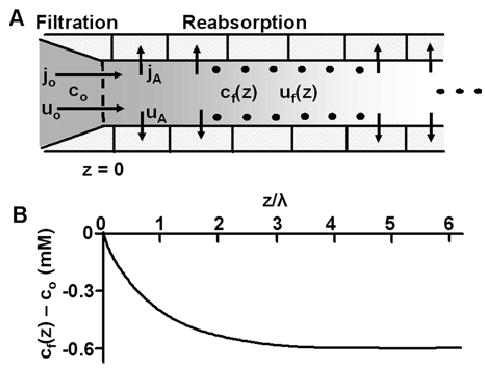Fig. 7.

Fluid and salt reabsorption in the renal proximal tubule. (A) The geometric and transport properties of the proximal tubule. The new filtrate cf= co (moles/cm3) is generated by the glomerulus at z = 0. As the filtrate flows along the lumen of the tubule, salt is transported out of the tubule across apical membranes at a rate jA (moles/cm2/s) and water follows at a rate uA (cm/s). The osmolarity of the transported solution, jA/uA (moles/cm3), is initially co/0.86 (Eq. 22 and related text), implying cf is decreasing with increasing distance from the glomerulus. The transport equations are derived in the text, where approximate solutions are presented. (B) A graphical representation of the solution for cf as a function of distance from the glomerulus. Based on parameter values in Table 2, ε = 10−3 and the total water permeabilities of apical and basolateral membranes are the same, hence α = 1. Initially cf = co = 300 mM, but it exponentially declines to its steady-state value of (1−(1+α)ε)co = 399.4 mM with a length constant λ = 0.3 cm. At steady state, the osmolarities of the transported solution and the filtrate are the same: cf = jA/uA.
